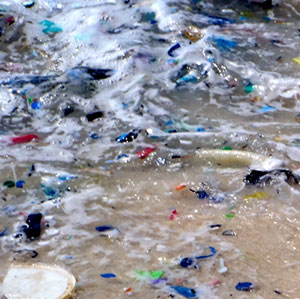We Finally Know Why Seabirds Eat Plastic
 Heartbreaking stories of
seabirds eating plastic — and the accompanying horrible images —
are everywhere, but now scientists are an important question: Why do seabirds
eat plastic in the first place?
Heartbreaking stories of
seabirds eating plastic — and the accompanying horrible images —
are everywhere, but now scientists are an important question: Why do seabirds
eat plastic in the first place? And why are some more likely to have bellies full of plastic than others?
The answer, it turns out,
lies in a compound called dimethyl sulfide, or DMS, which emits a
“chemical scream” that some birds associate with food.
When seabirds find chunks of plastic bobbing in the water, they gobble them up, not realizing that they’ve just consumed something very dangerous.
When seabirds find chunks of plastic bobbing in the water, they gobble them up, not realizing that they’ve just consumed something very dangerous.
Researchers at the
University of California, Davis took some samples of plastic sewn into mesh
bags and let them marinate in the ocean before bringing them to the viticulture lab, of all
places — the facility has incredibly sensitive equipment for sniffing out
unique chemical signatures.
Researchers found that
the plastic reeked — from a bird’s perspective, anyway — of DMS, a compound
emitted by algae as it breaks down.
Algae commonly emits DMS when it’s being snapped up by krill and other microorganisms that some birds feed on, so the smell is essentially like a dinner bell.
Algae commonly emits DMS when it’s being snapped up by krill and other microorganisms that some birds feed on, so the smell is essentially like a dinner bell.
This finding also
provided insight into why some birds are more prone to eating plastic than
others.
Birds that respond to DMS do so because they have a sensitivity to it, and use this scent to track down food sources. Seabirds that don’t rely on algae-eaters for food will still eat plastic, but in much smaller numbers.
The study could also
be helpful for examining plastic consumption in species beyond the bird
kingdom, and suggests that other compounds in plastics could send out their own
signals to hungry wildlife.
But there’s a kicker
to the plastic problem.
As plastic drifts in
the ocean, it can pick up other exotic chemical compounds, some
of which can make birds sick or kill them.
When birds respond to the siren song of DMS, they’re also taking in a load of other substances that are wildly unhealthy for them. Clearly, plastic in the ocean is a menace.
When birds respond to the siren song of DMS, they’re also taking in a load of other substances that are wildly unhealthy for them. Clearly, plastic in the ocean is a menace.
Now that we know why
some birds consume plastic, is there something we can do about it?
The long answer, of
course, is to get rid of plastics and continue aggressive campaigns to clean up
deposits of marine debris.
In the short term,
though, there’s another possible solution that involves formulating plastics to
be less appealing to algae and other organisms that produce DMS. If the
compound doesn’t form in the first place, plastic may be less likely to
register as a delicious source of potential food.